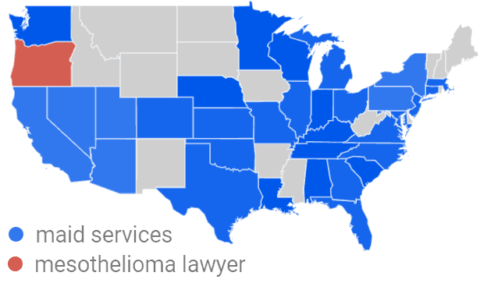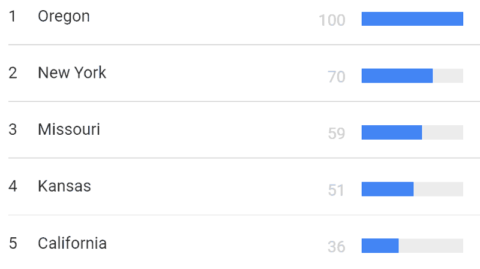If you visualize a typical X and Y axis graph, popular keywords are bunched up in a HUGE group to the left while descending to the right is a long descending line of less popular keywords numbering in maybe the trillions – It’s an ever growing list.
Given that 15% of search queries are unique and never been seen before and possibly in the long tail with other queries, it’s important to understand this part of search engine optimization.
The group of popular keywords on the left side are known as Head Terms and the group of less popular words on the right are known as the Long Tail.
Long Tail Keyword Myths
Contrary to popular thought, long tail keywords are not keyword phrases with a lot of words in them or keyword phrases with 20 or more characters.
This is a common mistake made when talking about long tail keywords.
What the Long Tail Actually Is
Long tail keywords are defined by how rare they are. This is an important distinction because there are many phrases that are comprised of 20 or more characters that are not part of the long tail because they account for a great many searches every day.
This distinction of what exactly is a long tail keyword phrase is even more important in the age of mobile and Internet of Things (IoT) because more people are speaking their search phrases with natural language terms.
An Example
For example, if you work at a bookstore you’re going to hear more requests for Harry Potter and the Chamber of Secrets by J. K. Rowling than one would for The Book of Thoth by Aleister Crowley.
Both books have their fans. But Harry Potter is analogous to a head term keyword phrase and The Book of Thoth is analogous to a long tail keyword phrase.
Long tail is about the relative rarity of its occurrence as a search phrase in Google. It’s not about how many words are in the keyword phrase.
History of The Long Tail
The Long Tail has its origin in a Wired magazine article by Chris Anderson that was titled The Long Tail
The article reflected on the notion of popularity and how popularity was artificially restricted by supply and demand. If the only songs you can listen to are the songs the radio stations play then that restricted playlist will result in an artificially created popularity, what Anderson termed:
“…the tyranny of lowest-common-denominator… Many of our assumptions about popular taste are actually artifacts of poor supply-and-demand matching—a market response to inefficient distribution.
…Hit-driven economics is a creation of an age without enough room to carry everything for everybody.”
His idea was to propose that the Internet frees us from the restraints of the physical world, the restraints of limited radio frequency bandwidth for channels and limited space in bookstores. That freedom opens the door to an immense audience that will like books by relatively obscure authors and for our purposes, results in traffic from relatively rare and obscure search terms.
What’s Good About Long Tail?
In general, long tail keywords can be difficult to optimize for. Google’s said that 15% of search queries are new. New search queries are the long tail. How does one optimize for a keyword that’s never been seen before?
But one should not necessarily write off 15% of all search queries for any given topic. There may be money in those search queries. So how do you optimize for long tail queries, particularly those that have never been seen before?
The only approach, in my opinion, is to create content with these four qualities:
- Avoid ambiguity
- Be precise
- Avoid going off-topic
- Answer the question, meet the needs of the search query.
Google will classify a new search query as belonging to a specific knowledge domain (topic) and assign an answer from web pages that are within that topic area, that address those topics.
This is, in my opinion, one of the scenarios for sites that rank for keyword phrases that don’t occur on the web pages. Content that is focused and unambiguously about a topic tends to perform well.
Which Long Tail Should You Chase?
Some long tail keywords are very competitive because success is lucrative. These long tail keywords are thus more valuable because of their scarcity.
For example, the supply of people genuinely seeking to hire a mesothelioma lawyer is relatively scarce. That makes this long tail keyword phrase more valuable. That value is reflected in the Pay Per Click competition for that keyword phrase.
Natural and Unnatural Long Tail Keywords
Historically many tools have shown a distorted estimate of what the real keyword demand is. Keyword tools have consistently shown the amount of keywords being searched by publishers checking their rankings and actual real people looking for answers.
 The unnatural distribution of the keyword phrase is an indication that the amount of keyword searches being reported are not from real people seeking answers.
The unnatural distribution of the keyword phrase is an indication that the amount of keyword searches being reported are not from real people seeking answers.In my experience the keyword volumes reported directly from search engines has always been unreliable. In my opinion and experience a certain percentage are publishers checking their search positions.
The above is a Google Trends illustration showing where keywords are popular. I compared it with another keyword phrase that is somewhat close. Normally the view by state has a mixed distribution. This map shows that a large percentage are coming from Oregon.
The illustration below shows the keyword distribution difference between the top five states for that keyword. California, one of the largest states by population has a third of the keyword volume as the much smaller state Oregon, as measured over a five year period.

Yet according to statistics compiled by Mesothelioma.com, Oregon had around 700 deaths attributed to Mesothelioma from 1999 to 2015 compared to over 4,000 deaths in California during the same period of time.
Given those statistics, one would think that Oregon would score one third the amount of search queries of California instead of the other way around. That seems to point out to how unreliable search query data can be due to competitive factors.
One way to tell if a long tail keyword phrase is worth pursuing is by the PPC competition.
There’s value in informational search queries, where people are seeking information about something. But unless you’re scaling hundreds of thousands or even millions of long tail search queries, it’s going to be tough to earn a living from ad impressions from long tail informational queries.
Long Tail Keywords for SEO
- Long tail search queries are profitable and not profitable
- Long tail search queries consist are short phrases and long phrases
- Long tail search phrases can’t always be predicted since many have never previously existed
- Long tail queries are not always three or more keywords
- Long tail keywords are sometimes two or less words in length
As should be evident now, keywords that are a part of the long tail have a lot more nuance than just keywords that are three or four words long. Furthermore, Google is getting better at understanding vague and unique queries because of technologies like BERT.




